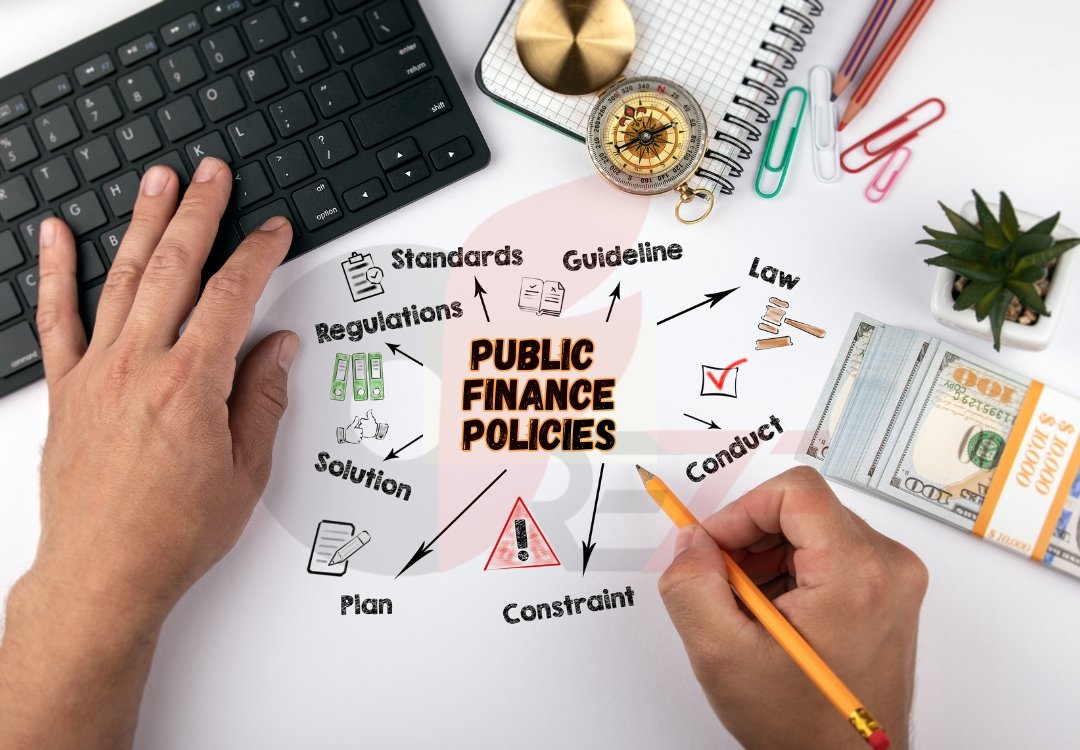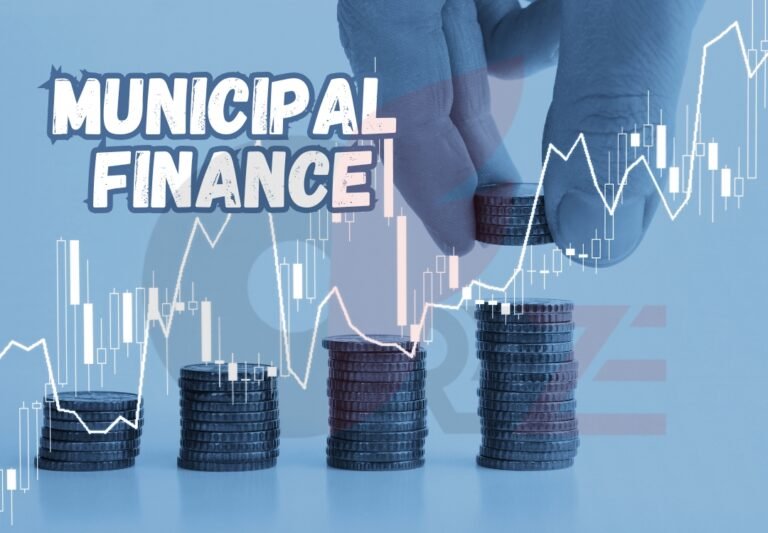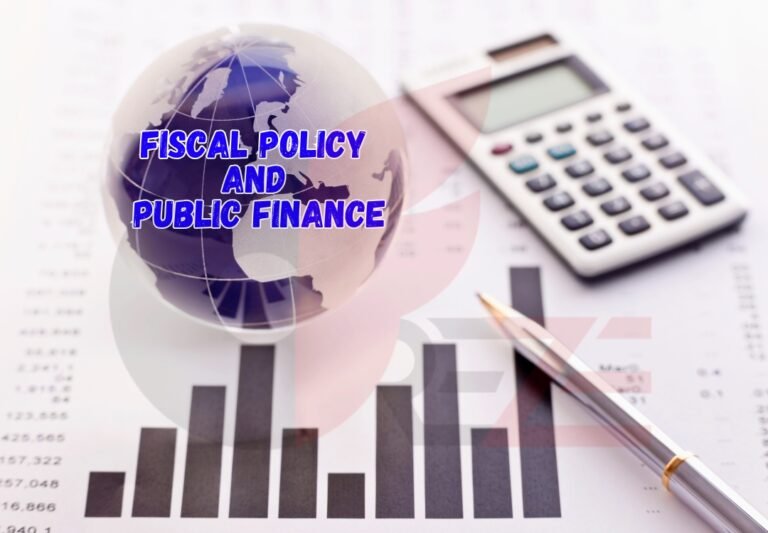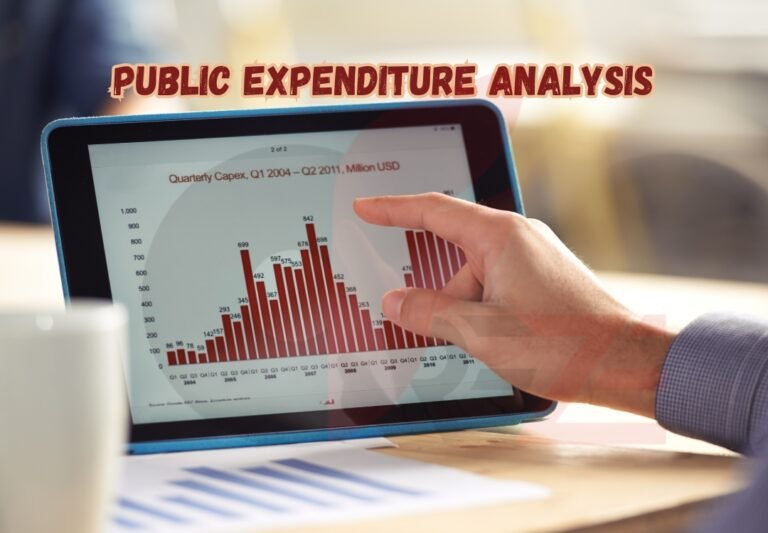Public Finance Policies and Their Role in Shaping National Economic Growth
Public finance is a critical pillar of any national economy, influencing everything from government revenue generation to the effective allocation of resources. It plays a fundamental role in shaping economic growth, stabilizing markets, and achieving long-term fiscal sustainability.

In this blog post, we will explore the connection between public finance policies and national economic growth, examining how decisions on taxation, government spending, and debt management impact the broader economy.
Public Finance Policies Introduction
At the heart of any nation’s fiscal structure lies its public finance policies. These policies consist of a range of decisions regarding government revenues, expenditures, borrowing, and financial management. The key aim of public finance is to efficiently mobilize resources to fund public goods and services, promote economic stability, and encourage sustainable development.
- But how exactly do these policies shape economic growth?
Economic growth refers to the increase in the production of goods and services in a country over time, often measured by the rise in Gross Domestic Product (GDP). Public finance policies directly influence the trajectory of economic growth by determining how government resources are allocated. This, in turn, affects everything from infrastructure development to the level of social welfare programs, education, and healthcare—all of which can either stimulate or hinder economic development.
Through strategic policy choices, governments can leverage public finance to foster an environment conducive to growth. For example, investing in infrastructure can lower the cost of doing business, while progressive taxation can redistribute wealth in ways that support consumption and productivity. On the other hand, poor fiscal management, excessive debt, and inefficient spending can stifle economic potential and create long-term challenges.
In this post, we’ll explore how different aspects of public finance policy contribute to or detract from national economic growth, providing both theoretical insights and real-world examples.
The Relationship Between Government Spending and Economic Development
Government spending plays a vital role in shaping the economic landscape. Public expenditures, when deployed strategically, can stimulate demand, create jobs, and foster a more productive economy. The key is in how and where governments choose to allocate their spending.
- Capital Investment vs. Current Expenditures
There are two broad categories of government spending: capital investment (long-term expenditures like infrastructure) and current expenditures (day-to-day operational costs like wages, benefits, and maintenance). Both types of spending can influence economic development in different ways.
-
- Capital Investment: Investments in infrastructure, such as building roads, bridges, ports, and energy systems, can have a multiplicative effect on economic growth. These projects not only create immediate jobs in construction but also lower long-term costs for businesses, making it easier for industries to thrive. For example, the expansion of transportation networks reduces logistics costs and facilitates trade, enhancing overall productivity in the economy.
- Current Expenditures: On the other hand, government spending on current needs like public services and social programs helps to maintain a stable, functioning society. Quality healthcare and education programs increase human capital, while unemployment benefits or subsidies can help sustain consumer demand during economic downturns.
The impact of government spending on economic development is often most noticeable in times of recession or economic slowdown. During such periods, increased public spending can serve as a counter-cyclical tool to boost aggregate demand and stimulate growth. Conversely, excessive government spending without adequate revenue generation can lead to budget deficits and debt accumulation, which can, in the long term, undermine economic stability.
Read More: Government Budgeting Process
Governments need to strike a balance between investing in future growth and maintaining fiscal discipline. Strategic spending that targets key areas of infrastructure, innovation, and human development can accelerate long-term economic development while ensuring the sustainability of public finances.
Tools for Revenue Generation and Economic Impact
Taxation is one of the primary mechanisms through which governments fund public services and investments. It is also a potent tool for influencing economic behavior. Effective tax policies are critical not just for raising revenue, but also for shaping the distribution of wealth, incentivizing investment, and promoting equitable growth.
- Types of Taxes and Their Economic Impact
Governments utilize a variety of taxes to generate revenue, each with different implications for economic growth.
-
- Progressive Taxes: These taxes are levied based on income or wealth, meaning the tax rate increases as the taxpayer’s ability to pay grows. Progressive taxation is often seen as a tool for reducing economic inequality, as it ensures that wealthier individuals contribute more to the public purse. However, high progressive tax rates can also discourage savings and investment if not structured effectively, leading to potential negative consequences on economic growth.
- Regressive Taxes: Regressive taxes, such as sales taxes or VAT (Value Added Tax), take a larger proportion of income from lower-income individuals. These taxes can limit consumer spending and disproportionately burden low-income households, which can slow down consumption-driven economic growth.
- Corporate Taxes: The taxation of businesses can have a significant impact on investment decisions. High corporate taxes may discourage firms from expanding or investing in new projects, as they face higher costs. On the other hand, tax cuts for businesses may encourage entrepreneurship and innovation, leading to higher levels of employment and economic output.
Tax policies are also essential for managing externalities. For example, taxes on carbon emissions or pollution can encourage companies to reduce their environmental footprint, supporting sustainable growth.
- Tax Reforms for Economic Growth
In many countries, tax reforms are used to enhance economic growth. Reforms might include lowering corporate tax rates to stimulate investment, broadening the tax base to increase revenue, or implementing tax credits to support innovation and research. The goal is to create an efficient and fair tax system that maximizes government revenue while minimizing the negative economic effects.
The relationship between taxation and growth is not straightforward, however. It depends on a country’s specific economic context, the structure of its tax system, and the use of tax revenues. When tax policies are designed with economic growth in mind—especially through investment in human capital, infrastructure, and innovation—they can significantly boost national economic performance.
Fiscal Policy and Its Role in Stabilizing the Economy
Fiscal policy refers to the government’s use of taxation and public spending to influence economic activity. It is one of the main tools governments use to stabilize the economy, smooth out business cycle fluctuations, and encourage long-term growth.
- Counter-Cyclical Fiscal Policy
A central feature of fiscal policy is its ability to act in a counter-cyclical manner. This means that during periods of economic downturn, the government can increase spending or reduce taxes to stimulate demand, and during periods of economic overheating (e.g., inflation), it can cut spending or raise taxes to cool down the economy.
For instance, during recessions, governments may increase public spending on infrastructure or social programs to help boost employment and consumer demand. By doing so, they can mitigate the impact of a downturn and support the recovery process. Conversely, in times of economic boom, governments may choose to cut back on spending or increase taxes to avoid inflation and ensure long-term stability.
- Government Deficits and Public Debt
One of the key challenges of fiscal policy is managing government deficits and public debt. While borrowing can provide the government with the resources to stimulate the economy during a recession, excessive debt accumulation can lead to long-term fiscal problems. High debt levels can result in higher interest payments, which take away funds that could be used for productive investments. This could lead to fiscal austerity measures and, in the worst case, a sovereign debt crisis.
The goal is to strike a balance between supporting economic growth and maintaining fiscal responsibility. Governments must carefully manage fiscal policy to avoid excessive debt and ensure that public spending is used effectively to support national growth objectives.
Public Debt Management and Its Long-term Economic Implications
Public debt management is a critical aspect of fiscal policy, as it determines how much the government borrows, how it repays its debt, and how it balances debt sustainability with economic growth. Properly managing public debt is essential to ensure that the government does not overburden future generations with unsustainable debt levels.
- The Role of Public Debt in Economic Growth
Debt is not inherently bad for an economy. In fact, well-managed public debt can be used to finance productive investments, such as infrastructure, education, or technology, which can yield long-term economic benefits. However, if debt levels become too high, they can crowd out private investment, increase borrowing costs, and lead to a loss of confidence in the government’s ability to meet its obligations.
Many countries have established debt-to-GDP ratios that serve as a guideline for sustainable debt management. If a country’s public debt grows too quickly relative to its GDP, it may face higher interest rates or struggle to finance new projects. Conversely, debt reduction through fiscal surpluses and other measures can provide the government with more financial flexibility in the future.
Effective debt management involves striking a balance between borrowing for investment and ensuring that debt levels remain sustainable over time. Governments need to create policies that prioritize high-return projects and generate sufficient economic activity to support debt repayment.
The Role of Government Investment in Infrastructure and Growth
One of the most significant ways that public finance policies influence economic growth is through investment in infrastructure. Public investment in critical infrastructure such as roads, bridges, airports, utilities, and telecommunications networks can have far-reaching effects on national economic performance. These investments create a foundation for long-term growth by improving productivity, reducing transaction costs, and fostering greater economic integration.
- Infrastructure and Productivity
Infrastructure is essential for increasing productivity in any economy. For example, improved transportation systems can reduce the time and costs associated with moving goods, while better energy infrastructure can provide more reliable and affordable power to businesses. The improvement of digital infrastructure, such as broadband internet access, enhances connectivity and opens new avenues for economic activity, particularly in emerging sectors like technology and e-commerce.
Public investment in infrastructure is also critical for regional development. Developing infrastructure in underdeveloped or rural areas can help reduce regional disparities, ensuring that growth is more inclusive. In many cases, governments use infrastructure projects to stimulate growth in lagging regions, creating jobs, and attracting private investment.
- Multiplier Effect of Infrastructure Investment
When the government invests in large infrastructure projects, the benefits extend beyond just the construction phase. These projects often have a multiplier effect, meaning that the initial investment leads to additional economic activity. For example, building a new highway not only generates jobs for construction workers, but also lowers transportation costs for businesses and increases the mobility of labor, thereby facilitating economic expansion.
Additionally, the long-term benefits of infrastructure investment often outweigh the initial costs. While the construction phase may be costly, the improved productivity and efficiency over time can lead to significant economic gains. Studies have shown that for every dollar spent on infrastructure, there can be a return of several dollars in economic growth over the long term.
- Public vs. Private Investment in Infrastructure
Governments often face budget constraints that make it difficult to finance large infrastructure projects entirely from public funds. This is where public-private partnerships (PPPs) come into play. PPPs allow the private sector to share the costs and risks of infrastructure development, while still ensuring that public goals such as accessibility and long-term sustainability are met. In this way, the government can expand its infrastructure projects without overwhelming its fiscal budget.
However, while PPPs can be effective, they require careful regulation to ensure that private interests do not outweigh public welfare. Governments need to ensure that these partnerships deliver value for money, maintain long-term commitments, and safeguard public interests.
Social Welfare Programs
Social welfare programs play an essential role in stabilizing the economy, especially during times of crisis or economic inequality. These programs include unemployment benefits, healthcare subsidies, housing assistance, and social security. While these programs are primarily designed to reduce poverty and improve social well-being, they also have important implications for economic growth.
- Economic Stability Through Social Safety Nets
During periods of economic recession or downturns, social welfare programs act as automatic stabilizers by supporting household income and maintaining consumption levels. When people are laid off, or businesses reduce their working hours, government transfers such as unemployment benefits help to cushion the blow. This not only supports the well-being of individuals but also helps sustain overall demand in the economy, preventing a deeper recession.
For example, in the aftermath of the 2008 financial crisis, countries that expanded unemployment insurance and social welfare programs saw quicker recoveries, as these programs helped maintain consumer demand. In contrast, countries that implemented austerity measures often faced deeper and more prolonged recessions.
- Balancing Redistribution and Economic Incentives
While social welfare programs are crucial for reducing poverty and inequality, they must be carefully designed to avoid disincentivizing work or productivity. If the benefits provided by these programs are too generous or are structured poorly, they can reduce the incentive for individuals to seek employment, which could harm economic growth.
Governments must strike a balance between offering sufficient support to those in need and ensuring that social programs encourage personal responsibility and self-sufficiency. For instance, conditional cash transfer programs, which require recipients to meet certain criteria (such as children attending school or receiving vaccinations), can be effective in promoting both social welfare and economic productivity.
Moreover, welfare programs that target education, healthcare, and job training can directly contribute to economic growth by improving human capital, which is a key driver of long-term productivity.
- Social Welfare and Economic Growth
The key challenge is finding the right mix of redistribution and economic incentives. Countries that have successfully managed social welfare systems, such as the Nordic model in Scandinavian countries, show that social programs can contribute to both economic growth and social equity. In these countries, universal healthcare, free education, and robust social security systems provide a high level of well-being, while still fostering high levels of productivity and innovation.
Public Finance and Economic Inequality: Challenges and Solutions
Economic inequality is a pervasive issue in many countries and can hinder long-term economic growth. Inequality can result from disparities in income, wealth, education, and access to opportunities. Public finance policies are crucial in addressing these inequalities, as they directly influence income distribution and social mobility.
- The Role of Taxation in Reducing Inequality
Taxation policies play a central role in redistributing wealth and reducing inequality. Progressive taxation, where higher incomes are taxed at higher rates, can help to bridge the wealth gap. These taxes allow the government to fund social programs and public services that benefit the broader population, particularly lower-income households.
For example, in countries with progressive tax systems, such as those in Europe, the government can fund universal healthcare, education, and housing programs, which help level the playing field and create more equal opportunities for citizens. However, for progressive taxation to work effectively, governments must ensure that tax loopholes are closed and that wealthy individuals and corporations pay their fair share.
- Social Mobility and Public Finance
Beyond taxation, public finance policies also influence economic inequality by shaping access to opportunities. Investment in education, healthcare, and skills development can promote social mobility—the ability of individuals to improve their socio-economic status through hard work and education.
Countries with high levels of inequality often suffer from lower levels of social mobility, as wealthier families can provide better educational opportunities for their children, giving them a head start in life. Public finance policies that focus on expanding access to quality education and healthcare can help break this cycle, allowing all individuals to reach their full potential.
Read More: Mastering Public Finance Management
For example, programs that provide subsidies for low-income families to send their children to college or invest in technical training can have significant long-term effects on reducing inequality and boosting economic growth.
The Impact of Tax Reforms on Economic Behavior and Growth
Tax reforms are one of the most potent tools governments have at their disposal to shape economic behavior. By changing the tax code—whether through reducing corporate taxes, changing personal income tax rates, or introducing new tax credits—governments can incentivize businesses and individuals to make decisions that align with national economic goals.
- Corporate Tax Cuts and Investment
One of the most widely discussed forms of tax reform is the reduction of corporate taxes. Lower corporate tax rates are often seen as a way to encourage investment, job creation, and economic expansion. By cutting taxes on businesses, governments can increase the after-tax return on investments, making it more attractive for companies to expand operations, invest in new technologies, and hire workers.
However, the effectiveness of corporate tax cuts depends on how the savings are used. If companies use the tax cuts to increase shareholder dividends or stock buybacks rather than investing in new projects, the benefits to economic growth may be limited. On the other hand, if businesses invest in new technologies or infrastructure, the economy can experience significant long-term growth.
- Personal Tax Cuts and Consumer Behavior
On the personal side, tax cuts can stimulate consumption and investment by leaving consumers with more disposable income. Lower personal income taxes can increase household spending, which in turn boosts demand for goods and services across the economy.
However, personal tax cuts must be carefully calibrated to avoid exacerbating inequality. For example, reducing taxes for the wealthy can lead to greater wealth disparity, while targeted cuts for low- and middle-income earners can provide an immediate boost to consumer demand and overall economic activity.
- Tax Incentives for Innovation
Tax incentives aimed at encouraging innovation and entrepreneurship are also important in fostering economic growth. Programs like research and development (R&D) tax credits, which provide businesses with financial incentives to invest in new technologies, can help stimulate technological progress and foster new industries.
These incentives are particularly important in knowledge-based economies, where innovation is a key driver of productivity and growth. By supporting R&D, governments can help create the conditions for long-term economic transformation and competitiveness.
Monetary Policy vs. Fiscal Policy
Monetary and fiscal policies are two of the primary tools that governments use to manage economic growth. While both are designed to influence economic activity, they operate through different mechanisms and serve complementary roles.
- Monetary Policy: Controlling Inflation and Interest Rates
Monetary policy, managed by a country’s central bank, involves the regulation of money supply and interest rates. The goal of monetary policy is typically to control inflation, stabilize the currency, and ensure a stable financial system. By adjusting interest rates, central banks can influence consumer and business behavior, impacting everything from investment decisions to housing markets.
Lower interest rates, for example, make borrowing cheaper, which encourages businesses to invest and consumers to spend. Conversely, raising interest rates can help curb inflation by making borrowing more expensive, thereby reducing demand in the economy.
- Fiscal Policy: Government Spending and Taxation
Fiscal policy, on the other hand, is concerned with government spending and taxation decisions. While monetary policy is often more focused on managing inflation and short-term economic stability, fiscal policy can be used to drive long-term economic growth by funding investments in infrastructure, education, and other critical areas.
Governments often use fiscal policy to stimulate the economy during recessions, just as central banks use monetary policy to achieve the same goal. In many cases, the most effective approach involves a combination of both policies, where fiscal stimulus is complemented by monetary easing to promote economic recovery and growth.
- Coordinating Monetary and Fiscal Policy for Growth
For these policies to be effective in fostering long-term growth, they must be well-coordinated. For instance, if the government increases spending on infrastructure while the central bank raises interest rates, the impact of the fiscal stimulus may be neutralized by the higher cost of borrowing. Similarly, overly expansionary fiscal policies combined with loose monetary policies can lead to inflation and economic instability.
By aligning monetary and fiscal policies, governments can create an environment that is conducive to sustainable economic growth.
Sustainable Development and Green Finance
In recent years, sustainable development has become a central focus of public finance policies, as governments around the world work to address the pressing challenges of climate change, resource depletion, and environmental degradation. Green finance, which focuses on funding projects that have positive environmental impacts, plays a key role in ensuring that economic growth is not achieved at the expense of the planet’s future.
- The Role of Green Finance in Economic Growth
Green finance refers to financial investments that support projects, technologies, and industries aimed at addressing environmental challenges. This includes renewable energy projects (such as solar and wind power), energy efficiency improvements, sustainable agriculture, and green infrastructure (such as smart cities and low-carbon transportation networks). Governments can encourage green finance through a variety of mechanisms, such as tax incentives, green bonds, and subsidies for clean energy technologies.
The growing emphasis on sustainability is not just an ethical imperative but also an economic one. Investment in clean technologies and green infrastructure can drive innovation, create jobs, and ensure that economies are better prepared for the future. For instance, the transition to renewable energy systems requires significant investment in research and development, energy storage solutions, and new infrastructure. This creates new industries and employment opportunities, while also reducing long-term reliance on fossil fuels.
Furthermore, integrating sustainability into public finance policies can help mitigate the economic risks posed by climate change. For example, policies aimed at reducing carbon emissions or incentivizing climate-resilient infrastructure can help prevent the economic disruptions that would result from climate-related disasters, such as floods, droughts, or extreme weather events.
- Public Policy Initiatives for Green Growth
Governments play a crucial role in incentivizing green finance by creating a policy environment that supports sustainable investment. One of the most effective ways to do this is by setting clear environmental goals, such as net-zero emissions targets or sustainable development objectives, and using public finance to direct investments towards achieving these goals. This might involve:
-
- Green Bonds: Governments can issue green bonds to raise capital for environmentally sustainable projects, allowing investors to contribute to initiatives such as renewable energy infrastructure or sustainable agriculture projects.
- Subsidies for Renewable Energy: Tax credits and subsidies for renewable energy companies encourage the growth of industries that are essential for a low-carbon economy, such as solar, wind, and electric vehicles.
- Carbon Pricing: Implementing carbon taxes or cap-and-trade systems can create financial incentives for companies to reduce their greenhouse gas emissions, while generating revenue that can be reinvested in sustainable development initiatives.
- Public-Private Partnerships: Governments can also collaborate with the private sector to fund green projects through public-private partnerships (PPPs). These partnerships can leverage both public and private capital to support large-scale green infrastructure projects, such as renewable energy grids, low-carbon transportation systems, and waste management solutions.
- Green Finance as a Driver of Long-Term Economic Growth
Investing in green finance is not just an environmental or social priority; it is also an economic opportunity. The global shift towards sustainable development has the potential to generate trillions of dollars in economic activity, creating new markets, industries, and job opportunities. Governments that prioritize green finance are better positioned to capitalize on these opportunities, making their economies more resilient, competitive, and sustainable in the long run.
Moreover, sustainable development helps future-proof economies by reducing the financial risks associated with climate change. Governments that take proactive steps to mitigate environmental risks and promote green growth will be better equipped to adapt to the challenges of the 21st century.
Public-Private Partnerships
Public-private partnerships (PPPs) are collaborations between governments and private sector companies that leverage private sector expertise, technology, and capital to fund and deliver public services and infrastructure projects. PPPs have become an increasingly popular method of financing large-scale projects, from infrastructure development to public services.
- How Public-Private Partnerships Work
PPPs are designed to combine the strengths of both the public and private sectors. The government provides the regulatory framework and ensures that public goals (such as accessibility and equity) are met, while the private sector provides funding, innovation, and management expertise. In return, private companies often receive a share of the profits generated by the projects or are compensated based on performance milestones.
For example, a government might enter into a PPP to develop a new toll road. The private partner would finance, build, and manage the road, while the government sets the toll rates and ensures that the road is accessible to the public. The private company profits from toll revenues, while the public benefits from a new, efficient road that boosts economic activity.
- Benefits of Public-Private Partnerships for Economic Growth
PPPs offer several advantages in terms of fostering economic growth:
-
- Access to Capital: One of the main benefits of PPPs is that they provide access to private capital, which can be particularly useful in times of fiscal constraint. By sharing the financial burden with the private sector, governments can pursue large-scale infrastructure projects without taking on excessive debt.
- Efficiency and Innovation: The private sector’s experience and expertise in managing large projects can lead to more efficient delivery of services. Private companies often bring innovative solutions to the table, leveraging technology and best practices to improve the design, construction, and operation of infrastructure projects.
- Job Creation and Economic Activity: Large infrastructure projects funded through PPPs often create thousands of jobs in construction, engineering, and related sectors. These jobs can have significant positive spillover effects on local economies by generating demand for goods and services.
- Risk Sharing: PPPs allow governments to share the financial and operational risks associated with large projects. In a traditional government-funded project, the public sector bears the entire risk, including cost overruns and delays. With a PPP, the private sector shares some of these risks, helping to ensure that projects are completed on time and within budget.
- Challenges and Risks of Public-Private Partnerships
Despite the advantages, PPPs are not without challenges. One of the main risks is ensuring that the private sector partner’s interests align with public goals. Without proper regulation, PPPs can lead to monopolistic practices, higher prices for consumers, or insufficient public benefits. Additionally, if the private partner fails to deliver on its commitments, it can place a financial burden on the government or taxpayers.
Effective governance, transparency, and regulation are essential to ensuring that PPPs deliver value for money and align with national growth objectives. Governments must carefully structure these agreements to ensure that both the private sector and the public sector benefit equally from the partnership.
The Effect of Public Finance Policies on Foreign Investment and Trade
Public finance policies can have a significant impact on a country’s ability to attract foreign investment and engage in international trade. Countries with sound fiscal policies, stable tax systems, and well-developed financial infrastructure are more likely to create a favorable environment for foreign investors. In turn, foreign investment can boost economic growth by creating jobs, increasing productivity, and facilitating the transfer of knowledge and technology.
- Foreign Direct Investment (FDI) and Economic Growth
Foreign direct investment (FDI) refers to investments made by foreign companies in a country’s businesses, industries, or infrastructure. FDI is a critical driver of economic growth, particularly in developing countries, as it provides capital, technology, and expertise that can enhance productivity and competitiveness.
Governments can attract FDI through sound public finance policies, including tax incentives, regulatory stability, and favorable trade agreements. Countries that offer favorable tax policies or tax breaks for foreign investors are often more attractive to multinational corporations seeking to expand their operations.
For example, tax holidays for foreign companies, reduced import duties, or subsidies for new technology can incentivize foreign firms to establish operations in a country, creating jobs and boosting local industries.
- Public Finance and Trade Policy
Trade policy is another critical aspect of public finance. Governments use fiscal and monetary tools to influence international trade, including tariffs, export subsidies, and trade agreements. Trade policies can open new markets for domestic businesses, increase the flow of goods and services, and improve a country’s balance of payments.
Effective trade policies help countries integrate into the global economy by ensuring access to key markets and facilitating the smooth flow of goods, services, and capital. Well-designed public finance policies that support trade—such as reducing trade barriers, streamlining customs procedures, and investing in transportation infrastructure—can enhance a country’s competitiveness and attract foreign investment.
The Role of Public Finance in Facilitating International Partnerships
Public finance policies also help governments establish strategic international partnerships. By using fiscal tools to support international trade agreements or to finance bilateral and multilateral projects, governments can increase their influence on the global stage, attract investment, and expand economic growth opportunities.
Case Studies
Around the world, there are numerous examples of countries that have successfully used public finance policies to drive sustained economic growth. These case studies offer valuable lessons about the effective use of government revenue, expenditures, and investments in promoting development.
- Example 1: Singapore’s Fiscal Policies and Economic Transformation
Singapore is often cited as a success story in terms of public finance and economic growth. The country has leveraged its strategic location, efficient government, and sound fiscal policies to become one of the world’s leading financial hubs. Singapore’s government has focused on investing in infrastructure, education, and technological innovation while maintaining a stable tax environment to attract foreign investment.
The government also carefully managed its public debt, using it to fund productive investments rather than excessive consumption. As a result, Singapore has consistently achieved high levels of economic growth and is considered one of the most business-friendly environments in the world.
- Example 2: Germany’s Social Market Economy
Germany’s social market economy has successfully balanced economic growth with social welfare. The country’s combination of market-driven policies, strong labor protections, and investment in education and infrastructure has created a highly productive and competitive economy. Germany’s public finance policies, including progressive taxation and public investment in R&D, have fostered long-term economic growth while ensuring social stability and low inequality.
Summary
Looking ahead, the role of public finance in shaping national and global economic growth will become even more important. As countries face the challenges of climate change, demographic shifts, technological disruption, and rising inequality, public finance policies will need to adapt to these new realities.
Governments will need to prioritize sustainable development, invest in human capital, and innovate in the way they finance economic growth. The future of public finance will involve greater integration between economic, social, and environmental goals, ensuring that growth is not only robust but also equitable and sustainable for future generations.
FAQs
Here are the frequently asked questions about Public Finance Policies and Their Role in Shaping National Economic Growth:
1. How Do Public Finance Policies Impact Long-Term Economic Stability?
Public finance policies are foundational to ensuring the long-term economic stability of a nation. These policies influence everything from fiscal discipline, debt management, to government spending, all of which can shape the trajectory of a country’s economic health.
The role of public finance in achieving economic stability lies in its ability to regulate national finances and create a balanced fiscal environment. For example, sound fiscal policies ensure that government spending doesn’t exceed revenues, preventing unsustainable deficits that could lead to inflation, higher interest rates, or even a debt crisis. A country with well-managed finances can withstand economic shocks and continue to invest in key areas like infrastructure, education, and healthcare—critical elements that boost productivity and economic resilience.
Moreover, government fiscal policies help smooth out economic cycles. During recessions, for instance, governments can implement counter-cyclical measures such as increased spending or tax cuts to stimulate demand. In contrast, during periods of strong economic growth, governments may raise taxes or cut back on spending to prevent the economy from overheating. This ability to manage fiscal policy helps avoid deep recessions or boom-and-bust cycles, contributing to a more stable economic environment.
Long-term stability also depends on a government’s ability to manage public debt responsibly. High levels of public debt, when unchecked, can lead to concerns about a nation’s solvency, which may reduce investor confidence and increase borrowing costs. By carefully planning debt issuance and ensuring that borrowed funds are used for productive investments (rather than simply covering day-to-day expenses), governments can maintain investor trust and ensure long-term economic growth.
Ultimately, public finance policies provide the framework that allows governments to allocate resources efficiently, manage risks, and maintain a stable macroeconomic environment—key ingredients for fostering sustainable economic growth and stability.
2. What Role Does Tax Policy Play in Enhancing National Economic Growth?
Tax policy is one of the most powerful tools governments have to stimulate economic growth. By adjusting tax rates and implementing tax incentives, governments can create the right incentives for businesses to invest, innovate, and create jobs, while also ensuring that revenues are collected in a way that supports public services and infrastructure.
- Tax Cuts and Investment Incentives
For businesses, tax reductions—particularly in corporate taxes—can significantly influence investment decisions. Lower tax rates allow companies to retain more of their profits, which they can reinvest into expansion, research and development (R&D), or higher wages for employees. This leads to increased productivity and economic output. For instance, when governments cut taxes on R&D or innovation, businesses are incentivized to innovate and invest in new technologies, which can further drive economic growth and competitiveness.
Corporate tax cuts also have an impact on foreign direct investment (FDI). Multinational corporations are more likely to invest in countries where the tax environment is favorable. By reducing corporate taxes or offering tax incentives for foreign investors, governments can attract global companies to set up operations locally, creating jobs and boosting productivity.
- Progressive Taxation and Economic Equity
On the other hand, progressive tax systems, which tax higher-income earners at higher rates, play a key role in reducing inequality. While high tax rates on the wealthy may seem controversial, they provide governments with the revenue needed to fund social programs that enhance overall economic welfare. These programs—such as healthcare, education, and social security—help reduce poverty and improve social mobility, which can have a long-term positive effect on economic productivity.
Moreover, taxes also enable governments to invest in essential public goods and infrastructure, such as roads, ports, and energy systems, which are necessary for businesses to operate efficiently and for the economy to grow. In this way, taxes not only redistribute wealth but also fund the physical and human capital investments that create an environment conducive to growth.
- Balancing Economic Growth and Fiscal Responsibility
The key challenge in tax policy is finding the right balance between incentivizing investment and ensuring the government collects enough revenue to fund public services. Excessive tax cuts, if not offset by spending cuts or other revenue sources, can lead to fiscal deficits, while overly burdensome taxes can stifle economic activity. Achieving the right balance ensures that tax policy supports economic growth while maintaining fiscal health.
3. What Are the Key Risks of Relying on Debt-Financed Public Investment for Economic Growth?
Debt-financed public investment has long been a tool for governments seeking to drive economic growth, particularly during times of crisis or when funds are unavailable from traditional revenue sources. While leveraging debt can provide the necessary capital for infrastructure projects or economic stimulus packages, it also comes with inherent risks that need careful consideration.
- Short-Term vs. Long-Term Debt Impact
The immediate advantage of borrowing is that it allows governments to fund large-scale projects—such as transportation infrastructure, healthcare systems, or educational reforms—that are crucial for long-term economic growth. For example, building new highways or investing in renewable energy infrastructure can stimulate employment, productivity, and innovation, leading to higher future tax revenues.
However, the key risk of relying on debt is the burden of repayment. If public debt is not managed carefully, it can accumulate over time and lead to unsustainable debt levels. As a result, governments may face higher interest payments, diverting resources away from vital public services. In extreme cases, excessive debt can lead to credit downgrades, rising borrowing costs, and, in the worst-case scenario, a sovereign debt crisis.
- The Dangers of Overleveraging
Another risk is that debt-financed investments may not always generate the returns needed to justify the borrowing. For example, if a government takes on debt to finance a large-scale infrastructure project, but that project fails to meet its economic goals (e.g., it doesn’t attract enough investment or increase productivity as expected), the country is left with both the burden of repayment and the lack of economic benefits. Overleveraging can be especially problematic in developing economies, where access to international capital markets may be limited, and the risks of default are higher.
- Economic Growth vs. Debt Sustainability
To avoid these risks, governments must prioritize investments that are not only productive in the short term but also provide long-term economic returns. Additionally, debt-financed projects should be carefully planned and evaluated to ensure they contribute to growth. Debt sustainability is also crucial—governments need to establish clear repayment schedules and limit borrowing to levels that can be sustained by future revenues.
A well-calibrated approach to debt-financed investment can unlock significant growth opportunities, but it must be managed with discipline and foresight to avoid long-term economic instability.
4. How Can Social Welfare Policies Foster Economic Growth Without Creating Dependency?
Social welfare programs—such as unemployment benefits, healthcare subsidies, and public housing—are essential components of a comprehensive public finance strategy, aimed at supporting vulnerable populations. While these programs are designed to reduce poverty and inequality, a key challenge is ensuring that they do not inadvertently create dependency, which can undermine long-term economic growth.
- Economic Stability and Consumption
One of the primary roles of social welfare is to provide economic stability. For example, during economic downturns, social safety nets, such as unemployment insurance, act as automatic stabilizers by sustaining household incomes and maintaining consumer spending. This helps prevent a sharp drop in demand for goods and services, which could otherwise exacerbate the economic downturn.
Furthermore, providing basic income security allows individuals to focus on long-term economic activities—such as improving skills, seeking better employment opportunities, or investing in education—without the immediate pressure of surviving on limited means. These opportunities, in turn, contribute to a more productive workforce, which is beneficial for the economy as a whole.
- Avoiding Dependency: Encouraging Self-Sufficiency
However, there is a concern that overly generous welfare programs could discourage people from seeking work, potentially leading to long-term dependency. To avoid this, governments must design welfare policies that encourage individuals to become self-sufficient. For instance, conditional cash transfers—which provide welfare payments on the condition that recipients meet certain criteria, such as attending job training or sending children to school—can be effective in ensuring that welfare programs encourage personal responsibility.
Additionally, investing in skills development, vocational training, and educational programs can help individuals move from reliance on welfare to meaningful employment. Programs that help people transition from welfare to work are crucial for reducing dependency while promoting long-term economic growth.
- The Role of Inclusive Growth
It’s also important to recognize that social welfare programs contribute to inclusive growth. By ensuring that everyone has access to basic needs—such as healthcare, education, and housing—governments help create an environment in which all citizens can participate in the economy. This inclusivity fosters broader-based productivity, as individuals from all walks of life can contribute to economic growth.
Thus, the challenge for public finance policies is to design welfare systems that strike a balance between providing a safety net and promoting opportunities for economic independence.
5. How Can Public Finance Policy Support the Transition to a Green, Sustainable Economy?
As the world confronts the dual challenges of economic growth and environmental sustainability, public finance policy plays a crucial role in facilitating the transition to a green economy. Governments are increasingly using fiscal tools to drive investments in renewable energy, low-carbon infrastructure, and sustainable industries.
- Green Finance and Investment in Sustainability
One of the most effective ways public finance can support sustainability is by directing investments towards environmentally-friendly projects. Green bonds, for example, allow governments to raise funds specifically for sustainable development projects, such as renewable energy infrastructure, energy-efficient buildings, and public transportation systems. By offering tax incentives for green investments or providing subsidies for sustainable technologies, governments can encourage businesses and investors to move towards more sustainable practices.
In addition, public spending on green infrastructure, such as smart grids or sustainable public transport systems, creates jobs, reduces emissions, and fosters innovation in green technologies. These investments not only contribute to the transition to a sustainable economy but also generate long-term economic growth by reducing reliance on fossil fuels and increasing energy efficiency.
- The Role of Carbon Pricing and Fiscal Incentives
Public finance policies also support sustainability by pricing carbon through mechanisms like carbon taxes or cap-and-trade systems. These policies create financial incentives for businesses to reduce their carbon emissions, ultimately driving the transition to a low-carbon economy. Governments can also use the revenue generated from these policies to reinvest in clean energy projects or to reduce taxes on green technologies, accelerating the shift towards a sustainable economic model.
Ultimately, integrating sustainability into public finance policies doesn’t just help the environment; it also lays the foundation for long-term, resilient economic growth. By investing in green technologies and infrastructure, governments create jobs, stimulate innovation, and position their economies for success in an increasingly green global marketplace.







